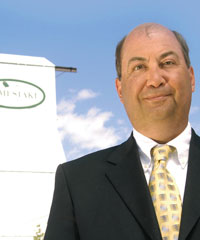Essay: Tom Nelson
 |
| Photo courtesy of Tom Nelson |
Mining a rich vein of science
Gold! That precious metal has been a constant measure of value to mankind. Fortunes have been made or lost, empires have risen or fallen, all in the pursuit of the Mother Lode.
Such is the case of Lead, South Dakota.
Not long after General George Custer and his expedition to the northern plains discovered gold in 1874 on the western edge of Dakota Territory, prospectors populated the area in hopes of getting rich quick. Several of these nomadic miners made their way to the heart of the Black Hills.
Californian George Hearst, who went on to build a fortune on mining, sent emissaries to the territory and began buying up claims. Thus were born Homestake Mining Company, the famous Wild West town of Deadwood, and the neighboring company town of Lead (pronounced leed).
For 125 years Homestake and Lead were one and the same. Generation upon generation worked for and in the mine, and people were born, lived their lives, and sometimes died for the company name.
Homestake was behind much of the modernization that came to Lead, and ultimately the entire region. The company needed power, lumber, water, and medical care; so it started an electric company, a sawmill, a water distribution and treatment system, and a hospital. The company wanted culture and activities for its workers, so it built an opera house and recreation center. Because of Homestake, the city of Lead boasted a quality of life seen at that time only in places like St. Louis and San Francisco.
At its peak, Homestakes Black Hills mine employed nearly 4000 workers. School children would learn the names of the companys general managers just as they would the presidents of the United States. The high school boasted a woodshop and metal shop that technical schools today would envy.
The 8000-foot-deep mining operation began to fade in the 1990s. The price of gold was falling and the cost of production skyrocketing. Despite a major downsizing and reinvestment in the capital plant in 1998, Homestake was doomed.
Around Lead it had often been said, When hell freezes over or Homestake closes! Hell finally froze over on September 11, 2000. Homestake announced that the Lead property was being shut down.
But the citizens of Lead had very little time to mourn. Within weeks, Richard Gowen of the South Dakota School of Mines & Technology, along with physicists from a variety of institutions, brought forth the idea that Homestake should be the site for a deep-level underground laboratory. Suddenly, the folks in Lead began to learn about some very strange and foreign thingsbeta decay, dark matter, and, of course, neutrinos.
The community embraced the next concept of what its hometown might become. The next February, and on the 23rd of that month every year since, Lead has celebrated the National Science Foundations initial visit to the proposed lab site with Neutrino Day. There is a Miss Neutrino, and school children participate in contests to determine exactly what they think a neutrino looks like.
The NSFs designation of Lead and Homestake as the site of the Deep Underground Science and Engineering Laboratory, or DUSEL, took much longer than originally hoped. In fact, the journey turned out to be a roller coaster! When the announcement came that the pumps that were keeping groundwater out of the mine were to be decommissioned, it seemed as though the project was lost. Legal maneuvers delayed the inevitable, but the pumps shut down and water began filling the mine at a rate of about 300 gallons a minute.
The greatest catalyst for the project came when Mike Rounds became governor of South Dakota in 2003. He and his staff recognized the paramount importance of this proposal and made it a priority early in his administration. His efforts to form strategic alliances and develop a cooperative consensus among government, the private sector, and the scientific community demonstrated that Homestake was just too good a site to pass by.
All that led to the formal donation of the site from Barrick Gold Corp. to the state, the creation of the South Dakota Science and Technology Authority, a gift of $70 million from South Dakotan T. Denny Sanford for infrastructure improvements and educational outreach, and finally the July 2007 designation of Lead as the home of DUSEL.
Lead boasts a wonderful past, an exciting present, and an awesome future. The community has always been about mining, and will continue to be about mining. Now, however, we are no longer mining gold, but science.
Tom Nelson, whose grandfather came to Lead at the age of 12 to work for Homestake Mining Company, is the mayor of Lead, a state senator, and the general manager of Gold Dust and Four Aces Gaming in Deadwood.
Click here to download the pdf version of this article.


